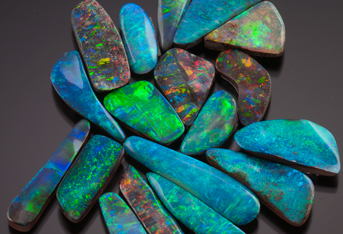What is A Boulder Opal?
“…For in them you shall see the living fire of the ruby, the glorious purple of the amethyst, the sea green of the emerald, all glittering together in an incredible mixture of light.”
Pliny, 1st Century A.D.
That says it all, well, perhaps not everything.
Opals are chemically composed of hydrated silica. In Gemmological terms this is an amorphous silicate (non-crystalline). In the opal’s case the amorphous silicate is about 5 to 10% H2O (water).
All precious opals have been formed from spherical particles of this amorphous silica. In a gem opal, the spheres are of a uniform size and are packed together in a very regular manner. This structure, too small to be seen even with the aid of an optical microscope, is easily visible when replicas of fractured surfaces are viewed under an electron microscope.
This packing of spheres diffracts light at various wavelengths which creates the myriad of colors that the opal displays. Depending on how you view the opal, angle and quality of light, determines the diffraction of the light from the opal that reaches your eye. The packing of the spheres, the angle, the lighting and your eye all come together to give the opal its’ unique beauty of radiant color.
The Australian Boulder Opal occurs in the area of Queensland. The precious opal is found in ironstone boulders (iron stained sandstone). This opal usually exhibits a bright display of black opal color.
Queensland’s southwest opal fields (Quilpie, Yowah, Eromanga) are important sources of boulder opals. The fields in these areas are in sediments from the Cretaceous age (100 million years ago). Most opals were formed in deeply weathered rocks in arid regions. During high rainfall periods, small amounts of silica were dissolved by water. As the water evaporated, the remaining silica formed the minute spheres. When these spheres were packed into tight regular formations they formed the gem quality opal that is treasured around the world today.
So, scientifically speaking, opals are:
“Tightly packed, regular rows of amorphous silicates (Hydrated Silica (SiOH2o)) that are 5 to 10% water, cut and polished to reflect diffracted light back to the eye.”
But the words of a poet more accurately connect the opal to the human heart and soul:
“And lo! the beautiful opal – That rare and wondrous gem – Where the Moon and Sun blend into one is the child that was born to them.”


